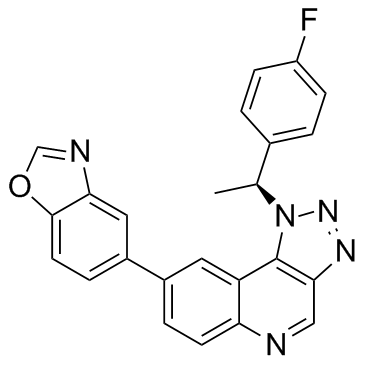| Description |
CLK1-IN-1 is a potent and selective of Cdc2-like kinase 1 (CLK1) inhibitor, with an IC50 of 2 nM.
|
| Related Catalog |
|
| Target |
CLK1:2 nM (IC50)
|
| In Vitro |
CLK1 is the most potently inhibited kinase (IC50: 2 nM). In addition to CLK1, only two kinases have an IC50 value less than 100 nM, namely CLK2 (IC50: 31 nM) and CLK4 (IC50: 8 nM), DYRK1A is the strongest off-target. The ability of CLK1-IN-1 to induce autophagy in BNL CL.2 and SKOV-3 (human ovarian cancer cell line) cells is also examined. The effects of CLK1-IN-1 on yellow LC3 puncta also displays obvious dose dependency, and a dose of 10 μM shows the best performance. In addition, in CLK1-IN-1-treated cells, the number of red LC3 puncta (mRFP signals only35) increases compared with that of DMSO-treated cells, indicating the formation of autolysosomes. Importantly, CLK1-IN-1 stimulats the degradation of SQSTM1/p62 and increases the ratio of red LC3 puncta to yellow LC3 puncta, both of which indicate an induction of autophagic flux by CLK1-IN-1[1].
|
| In Vivo |
APAP exposure results in severe liver injury, and treatment with CLK1-IN-1 (ip, 30 mg/kg) imparts a significant hepatoprotective effect. The results show that treatment with CLK1-IN-1 decreases serum ALT and AST levels significantly such that both marker enzymes return to normal levels[1].
|
| Cell Assay |
BNL CL.2 (mouse embryonic liver cell line) is selected, and three concentrations (20 nM, 100 nM, and 10 μM) of CLK1-IN-1 are used[1].
|
| Animal Admin |
Mice[1] Drug-induced liver injury (DILI) is a major public health concern and accounts for more than 50% of acute liver failure cases. APAP is a widely used antipyretic analgesic drug. Herein, the APAP-induced hepatotoxicity mouse model is used to examine the therapeutic effect of CLK1-IN-1 in vivo. Male C57BL/6 mice are given either saline (n=3, ip) or APAP (500 mg/kg) (n=15, ip). To examine the hepatoprotective effect, mice are injected (ip) with CLK1-IN-1 (25) (30 mg/kg), 30 (30 mg/kg, positive control), rapamycin (30 mg/kg, positive control), or solvent (12.5% ethanol and 12.5% castor oil, 10 mL/kg), immediately followed by APAP (500 mg/kg) injection (ip). All mice are sacrificed 6 h later. Liver sections are examined by H&E staining, and the serum from the blood samples is used for ALT and AST activity tests[1].
|
| References |
[1]. Sun QZ, et al. Discovery of Potent and Selective Inhibitors of Cdc2-Like Kinase 1 (CLK1) as a New Class of Autophagy Inducers. J Med Chem. 2017 Jul 27;60(14):6337-6352.
|
